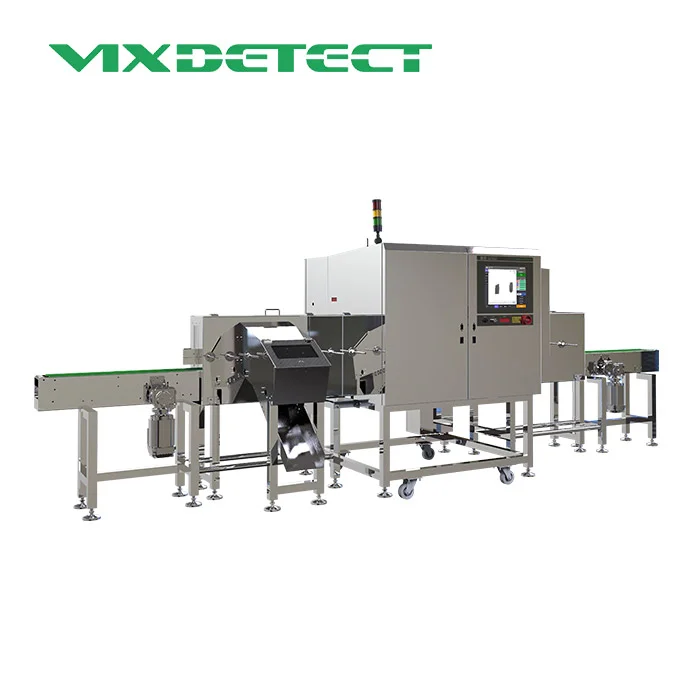In the global food industry, canned food is popular for its long-term preservation and convenience. As consumers' requirements for food safety and quality continue to increase, food producers face more challenges, especially in ensuring the safety and pollution-free of canned food. In this context, X-ray detection technology has become an indispensable means, providing strong protection for the production process of canned food.
1. What is X-ray detection of canned food?
X-ray detection is a non-destructive detection technology that uses high-energy X-rays to penetrate food packaging, image the inside of the food, and detect possible foreign matter, voids, leaks, and other problems. Unlike traditional metal detectors, X-ray detection can identify non-metallic foreign matter, such as glass, plastic, rubber, etc., and can perform real-time detection without destroying the packaging, with high accuracy and effectiveness.
For canned food, X-ray detection can monitor the quality of the product in real time on the production line to ensure that each can of food meets the quality standards when it leaves the factory. Whether it is to detect whether there is foreign matter inside the food or to ensure that the can is sealed intact, X-ray detection can provide efficient and accurate solutions.

2. Working Principle
The core principle of X-ray detection is to use the different characteristics of X-rays penetrating materials to generate images by measuring the difference in X-ray intensity after penetrating the material. In canned food detection, X-rays are irradiated into the interior through the packaging material. Different components inside the food absorb X-rays to different degrees, so images can be formed through these differences.
Foreign matter detection: X-rays can detect foreign matter inside food, especially some non-metallic foreign matter that metal detectors cannot identify. For example, during the canning process, plastic, glass fragments, etc. may enter the cans. X-rays can clearly show these objects and help inspectors to remove unqualified products in time.
Can seal detection: X-rays can also be used to detect the sealing status of cans. By analyzing the density difference between the outside and inside of the can, it can be determined whether the can has problems such as air leakage and bubbles. Poorly sealed cans may cause food to deteriorate, so this test is crucial.
Product consistency check: X-ray technology can also effectively check whether the filling amount of canned food meets the standard, ensuring that the capacity of each can of food is consistent to avoid too much or too little.
3. Advantages of X-ray Inspection of Canned Food
High precision and high efficiency: X-ray inspection can accurately identify foreign objects inside canned food and can be monitored in real time on the production line. Compared with manual inspection, X-ray inspection is more efficient and can significantly improve production efficiency while reducing errors caused by human operation.
Non-destructive inspection: Unlike traditional destructive inspection methods (such as can opening inspection), X-ray inspection is non-destructive and does not affect the appearance and quality of the product. Therefore, the food can remain in its original appearance during the inspection process to ensure the integrity of the product.
Versatility: X-ray inspection systems can not only detect metal foreign objects, but also identify non-metallic foreign objects, food filling volume, sealing status and other issues. This versatility makes X-ray inspection a very ideal quality control tool in the food industry.
Automation and real-time monitoring: X-ray inspection can be integrated with the production line automation system to monitor the quality of each can of food in real time to ensure that no defective products appear during the production process. This automated monitoring helps to reduce labor costs while ensuring the consistency of product quality.
4. Application
There are many types of canned foods, and different types of canned foods have different requirements and difficulties in X-ray inspection. Here are some common canned foods and their X-ray inspection applications:
Canned meat: Canned meat is a breeding ground for bacteria and other foreign matter due to its rich fat and diverse ingredients. X-ray inspection can ensure that unqualified foreign matter, such as metal fragments, glass pieces, etc., is not mixed in during the production process.
Canned fruits and vegetables: For canned fruits and vegetables, X-ray inspection can help detect foreign matter and ensure that the filling amount inside the food meets the standard. Especially for canned foods containing syrup or juice, X-rays can effectively check the filling consistency and sealing status of the product.
Canned seafood: The inspection requirements for canned seafood are more stringent because seafood products are susceptible to bacterial contamination. X-ray technology can help detect foreign matter inside seafood cans, whether there is a poor seal, etc.
Canned food X-ray inspection technology is undoubtedly a key tool to ensure food safety and high quality. It can not only improve production efficiency, but also accurately detect foreign matter, filling amount and sealing in food, ensuring that consumers can get high-quality canned food. With the development of technology, X-ray inspection will play an increasingly important role in canned food production and become an indispensable part of the food industry. In the pursuit of food safety and quality, X-ray inspection provides strong technical support for manufacturers. As a food X-ray machine manufacturer, we are committed to providing advanced quality inspection solutions for the food industry, helping manufacturers ensure product safety and quality, bringing safer and higher-quality products to consumers, and promoting safe production and healthy development of the food industry.
www.vixdetect.net
Shanghai Vixdetect Inspection Equipment Co., Ltd.
